【ASP.NET Core分布式项目实战】(三)整理IdentityServer4 MVC授权、Consent功能实现
前言
由于之前的博客都是基于其他的博客进行开发,现在重新整理一下方便以后后期使用与学习
新建IdentityServer4服务端
服务端也就是提供服务,如QQ Weibo等。
新建项目解决方案AuthSample.
新建一个ASP.NET Core Web Application 项目MvcCookieAuthSample,选择模板Web 应用程序 不进行身份验证。
给网站设置默认地址 http://localhost:5000

第一步:添加Nuget包:IdentityServer4
添加IdentityServer4 引用:
Install-Package IdentityServer4
第二步:添加Config.cs配置类
然后添加配置类Config.cs:

using System; using System.Collections.Generic; using System.Linq; using System.Threading.Tasks; using IdentityServer4; using IdentityServer4.Models; using IdentityServer4.Test; namespace MvcCookieAuthSample { public class Config { //所有可以访问的Resource public static IEnumerable<ApiResource> GetApiResources() { return new List<ApiResource>() { new ApiResource("api1","API Application") }; } //客户端 public static IEnumerable<Client> GetClients() { return new List<Client> { new Client{ ClientId="mvc", AllowedGrantTypes=GrantTypes.Implicit,//模式:隐式模式 ClientSecrets={//私钥 new Secret("secret".Sha256()) }, AllowedScopes={//运行访问的资源 IdentityServerConstants.StandardScopes.Profile, IdentityServerConstants.StandardScopes.OpenId, }, RedirectUris={"http://localhost:5001/signin-oidc"},//跳转登录到的客户端的地址 PostLogoutRedirectUris={"http://localhost:5001/signout-callback-oidc"},//跳转登出到的客户端的地址 RequireConsent=false//是否需要用户点击确认进行跳转 } }; } //测试用户 public static List<TestUser> GetTestUsers() { return new List<TestUser> { new TestUser{ SubjectId="10000", Username="wyt", Password="password" } }; } //定义系统中的资源 public static IEnumerable<IdentityResource> GetIdentityResources() { return new List<IdentityResource> { //这里实际是claims的返回资源 new IdentityResources.OpenId(), new IdentityResources.Profile(), new IdentityResources.Email() }; } } }
第三步:添加Startup配置
引用命名空间:
using IdentityServer4;
然后打开Startup.cs 加入如下:
services.AddIdentityServer() .AddDeveloperSigningCredential()//添加开发人员签名凭据 .AddInMemoryApiResources(Config.GetApiResources())//添加内存apiresource .AddInMemoryClients(Config.GetClients())//添加内存client .AddInMemoryIdentityResources(Config.GetIdentityResources())//添加系统中的资源 .AddTestUsers(Config.GetTestUsers());//添加测试用户
public void Configure(IApplicationBuilder app, IHostingEnvironment env) { ... app.UseIdentityServer(); ... }
注册登录实现
我们还需要新建一个ViewModels,在ViewModels中新建RegisterViewModel.cs和LoginViewModel.cs来接收表单提交的值以及来进行强类型视图

using System.ComponentModel.DataAnnotations; namespace MvcCookieAuthSample.ViewModels { public class RegisterViewModel { [Required]//必须的 [DataType(DataType.EmailAddress)]//内容检查是否为邮箱 public string Email { get; set; } [Required]//必须的 [DataType(DataType.Password)]//内容检查是否为密码 public string Password { get; set; } [Required]//必须的 [DataType(DataType.Password)]//内容检查是否为密码 public string ConfirmedPassword { get; set; } } }

using System; using System.Collections.Generic; using System.ComponentModel.DataAnnotations; using System.Linq; using System.Threading.Tasks; namespace MvcCookieAuthSample.ViewModels { public class LoginViewModel { [Required] public string UserName { get; set; } [Required]//必须的 [DataType(DataType.Password)]//内容检查是否为密码 public string Password { get; set; } } }
在Controllers文件夹下新建AdminController.cs

using System; using System.Collections.Generic; using System.Linq; using System.Threading.Tasks; using Microsoft.AspNetCore.Mvc; namespace MvcCookieAuthSample.Controllers { public class AdminController : Controller { public IActionResult Index() { return View(); } } }
在Views文件夹下新建Admin文件夹,并在Admin文件夹下新建Index.cshtml

@{ ViewData["Title"] = "Admin"; } <h2>@ViewData["Title"]</h2> <p>Admin Page</p>
在Controllers文件夹下新建AccountController.cs

using System; using System.Collections.Generic; using System.Linq; using System.Threading.Tasks; using Microsoft.AspNetCore.Mvc; using IdentityServer4.Test; using Microsoft.AspNetCore.Identity; using MvcCookieAuthSample.ViewModels; using Microsoft.AspNetCore.Authentication; namespace MvcCookieAuthSample.Controllers { public class AccountController : Controller { private readonly TestUserStore _users; public AccountController(TestUserStore users) { _users = users; } //内部跳转 private IActionResult RedirectToLocal(string returnUrl) { if (Url.IsLocalUrl(returnUrl)) {//如果是本地 return Redirect(returnUrl); } return RedirectToAction(nameof(HomeController.Index), "Home"); } //添加验证错误 private void AddError(IdentityResult result) { //遍历所有的验证错误 foreach (var error in result.Errors) { //返回error到model ModelState.AddModelError(string.Empty, error.Description); } } public IActionResult Register(string returnUrl = null) { ViewData["returnUrl"] = returnUrl; return View(); } [HttpPost] public async Task<IActionResult> Register(RegisterViewModel registerViewModel, string returnUrl = null) { return View(); } public IActionResult Login(string returnUrl = null) { ViewData["returnUrl"] = returnUrl; return View(); } [HttpPost] public async Task<IActionResult> Login(LoginViewModel loginViewModel, string returnUrl = null) { if (ModelState.IsValid) { ViewData["returnUrl"] = returnUrl; var user = _users.FindByUsername(loginViewModel.UserName); if (user==null) { ModelState.AddModelError(nameof(loginViewModel.UserName), "UserName not exists"); } else { if (_users.ValidateCredentials(loginViewModel.UserName,loginViewModel.Password)) { //是否记住 var prop = new AuthenticationProperties { IsPersistent = true, ExpiresUtc = DateTimeOffset.UtcNow.Add(TimeSpan.FromMinutes(30)) }; await Microsoft.AspNetCore.Http.AuthenticationManagerExtensions.SignInAsync(HttpContext, user.SubjectId, user.Username, prop); } } return RedirectToLocal(returnUrl); } return View(); } public async Task<IActionResult> Logout() { await HttpContext.SignOutAsync(); return RedirectToAction("Index", "Home"); } } }
然后在Views文件夹下新增Account文件夹并新增Register.cshtml与Login.cshtml视图

@{ ViewData["Title"] = "Register"; } @using MvcCookieAuthSample.ViewModels; @model RegisterViewModel; <h2>@ViewData["Title"]</h2> <h3>@ViewData["Message"]</h3> <div class="row"> <div class="col-md-4"> @* 这里将asp-route-returnUrl="@ViewData["returnUrl"],就可以在进行register的post请求的时候接收到returnUrl *@ <form method="post" asp-route-returnUrl="@ViewData["returnUrl"]"> <h4>Create a new account.</h4> <hr /> @*统一显示错误信息*@ <div class="text-danger" asp-validation-summary="All"></div> <div class="form-group"> <label asp-for="Email"></label> <input asp-for="Email" class="form-control" /> <span asp-validation-for="Email" class="text-danger"></span> </div> <div class="form-group"> <label asp-for="Password"></label> <input asp-for="Password" class="form-control" /> <span asp-validation-for="Password" class="text-danger"></span> </div> <div class="form-group"> <label asp-for="ConfirmedPassword"></label> <input asp-for="ConfirmedPassword" class="form-control" /> <span asp-validation-for="ConfirmedPassword" class="text-danger"></span> </div> <button type="submit" class="btn btn-default">Register</button> </form> </div> </div>

@{ ViewData["Title"] = "Login"; } @using MvcCookieAuthSample.ViewModels; @model LoginViewModel; <div class="row"> <div class="col-md-4"> <section> <form method="post" asp-controller="Account" asp-action="Login" asp-route-returnUrl="@ViewData["returnUrl"]"> <h4>Use a local account to log in.</h4> <hr /> @*统一显示错误信息*@ <div class="text-danger" asp-validation-summary="All"></div> <div class="form-group"> <label asp-for="UserName"></label> <input asp-for="UserName" class="form-control" /> <span asp-validation-for="UserName" class="text-danger"></span> </div> <div class="form-group"> <label asp-for="Password"></label> <input asp-for="Password" type="password" class="form-control" /> <span asp-validation-for="Password" class="text-danger"></span> </div> <div class="form-group"> <button type="submit" class="btn btn-default">Log in</button> </div> </form> </section> </div> </div> @section Scripts { @await Html.PartialAsync("_ValidationScriptsPartial") }
我们接下来要修改_Layout.cshtml视图页面判断注册/登陆按钮是否应该隐藏
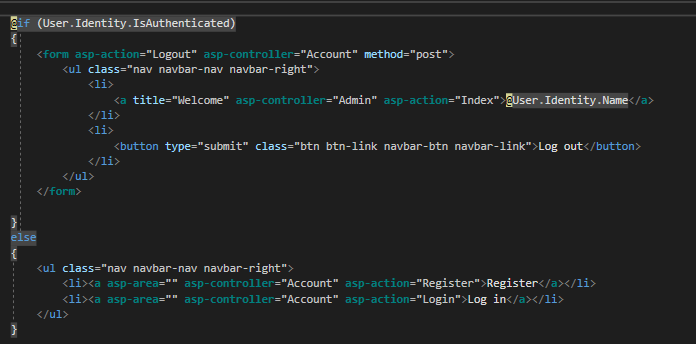
完整的_Layout.cshtml代码:

<!DOCTYPE html>
<html>
<head>
<meta charset="utf-8" />
<meta name="viewport" content="width=device-width, initial-scale=1.0" />
<title>@ViewData["Title"] - MvcCookieAuthSample</title>
<environment include="Development">
<link rel="stylesheet" href="~/lib/bootstrap/dist/css/bootstrap.css" />
<link rel="stylesheet" href="~/css/site.css" />
</environment>
<environment exclude="Development">
<link rel="stylesheet" href="https://ajax.aspnetcdn.com/ajax/bootstrap/3.3.7/css/bootstrap.min.css"
asp-fallback-href="~/lib/bootstrap/dist/css/bootstrap.min.css"
asp-fallback-test-class="sr-only" asp-fallback-test-property="position" asp-fallback-test-value="absolute" />
<link rel="stylesheet" href="~/css/site.min.css" asp-append-version="true" />
</environment>
</head>
<body>
<nav class="navbar navbar-inverse navbar-fixed-top">
<div class="container">
<div class="navbar-header">
<button type="button" class="navbar-toggle" data-toggle="collapse" data-target=".navbar-collapse">
<span class="sr-only">Toggle navigation</span>
<span class="icon-bar"></span>
<span class="icon-bar"></span>
<span class="icon-bar"></span>
</button>
<a asp-area="" asp-controller="Home" asp-action="Index" class="navbar-brand">MvcCookieAuthSample</a>
</div>
<div class="navbar-collapse collapse">
<ul class="nav navbar-nav">
<li><a asp-area="" asp-controller="Home" asp-action="Index">Home</a></li>
<li><a asp-area="" asp-controller="Home" asp-action="About">About</a></li>
<li><a asp-area="" asp-controller="Home" asp-action="Contact">Contact</a></li>
</ul>
@if (User.Identity.IsAuthenticated)
{
<form asp-action="Logout" asp-controller="Account" method="post">
<ul class="nav navbar-nav navbar-right">
<li>
<a title="Welcome" asp-controller="Admin" asp-action="Index">@User.Identity.Name</a>
</li>
<li>
<button type="submit" class="btn btn-link navbar-btn navbar-link">Log out</button>
</li>
</ul>
</form>
}
else
{
<ul class="nav navbar-nav navbar-right">
<li><a asp-area="" asp-controller="Account" asp-action="Register">Register</a></li>
<li><a asp-area="" asp-controller="Account" asp-action="Login">Log in</a></li>
</ul>
}
</div>
</div>
</nav>
<div class="container body-content">
@RenderBody()
<hr />
<footer>
<p>© 2018 - MvcCookieAuthSample</p>
</footer>
</div>
<environment include="Development">
<script src="~/lib/jquery/dist/jquery.js"></script>
<script src="~/lib/bootstrap/dist/js/bootstrap.js"></script>
<script src="~/js/site.js" asp-append-version="true"></script>
</environment>
<environment exclude="Development">
<script src="https://ajax.aspnetcdn.com/ajax/jquery/jquery-2.2.0.min.js"
asp-fallback-src="~/lib/jquery/dist/jquery.min.js"
asp-fallback-test="window.jQuery"
crossorigin="anonymous"
integrity="sha384-K+ctZQ+LL8q6tP7I94W+qzQsfRV2a+AfHIi9k8z8l9ggpc8X+Ytst4yBo/hH+8Fk">
</script>
<script src="https://ajax.aspnetcdn.com/ajax/bootstrap/3.3.7/bootstrap.min.js"
asp-fallback-src="~/lib/bootstrap/dist/js/bootstrap.min.js"
asp-fallback-test="window.jQuery && window.jQuery.fn && window.jQuery.fn.modal"
crossorigin="anonymous"
integrity="sha384-Tc5IQib027qvyjSMfHjOMaLkfuWVxZxUPnCJA7l2mCWNIpG9mGCD8wGNIcPD7Txa">
</script>
<script src="~/js/site.min.js" asp-append-version="true"></script>
</environment>
@RenderSection("Scripts", required: false)
</body>
</html>
最后给AdminController加上 [Authorize] 特性标签即可
然后我们就可以运行网站,输入用户名和密码进行登录了
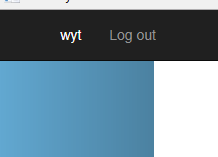
新建客户端
新建一个MVC网站MvcClient
dotnet new mvc --name MvcClient
给网站设置默认地址 http://localhost:5001

MVC的网站已经内置帮我们实现了Identity,所以我们不需要再额外添加Identity引用
添加认证
services.AddAuthentication(options => { options.DefaultScheme = "Cookies";//使用Cookies认证 options.DefaultChallengeScheme = "oidc";//使用oidc }) .AddCookie("Cookies")//配置Cookies认证 .AddOpenIdConnect("oidc",options=> {//配置oidc options.SignInScheme = "Cookies"; options.Authority = "http://localhost:5000"; options.RequireHttpsMetadata = false; options.ClientId = "mvc"; options.ClientSecret = "secret"; options.SaveTokens = true; });
在管道中使用Authentication
app.UseAuthentication();
接下来我们在HomeController上打上 [Authorize] 标签,然后启动运行
我们这个时候访问首页http://localhost:5001会自动跳转到ocalhost:5000/account/login登录

登录之后会自动跳转回来

我们可以在Home/About页面将claim的信息显示出来

@{ ViewData["Title"] = "About"; } <h2>@ViewData["Title"]</h2> <h3>@ViewData["Message"]</h3> <dl> @foreach (var claim in User.Claims) { <dt>@claim.Type</dt> <dt>@claim.Value</dt> } </dl>

这边的内容是根据我们在IdentityServer服务中定义的返回资源决定的

Consent功能实现
首先在ViewModels文件夹下创建两个视图模型
ScopeViewModel.cs

using System; using System.Collections.Generic; using System.Linq; using System.Threading.Tasks; namespace MvcCookieAuthSample.ViewModels { //领域 public class ScopeViewModel { public string Name { get; set; } public string DisplayName { get; set; } public string Description { get; set; } public bool Emphasize { get; set; } public bool Required { get; set; } public bool Checked { get; set; } } }
ConsentViewModel.cs

using System; using System.Collections.Generic; using System.Linq; using System.Threading.Tasks; namespace MvcCookieAuthSample.ViewModels { public class ConsentViewModel { public string ClientId { get; set; } public string ClientName { get; set; } public string ClientUrl { get; set; } public string ClientLogoUrl { get; set; } public bool AllowRememberConsent { get; set; } public IEnumerable<ScopeViewModel> IdentityScopes { get; set; } public IEnumerable<ScopeViewModel> ResourceScopes { get; set; } } }
我们在MvcCookieAuthSample项目中添加新控制器ConsentController

using System; using System.Collections.Generic; using System.Linq; using System.Threading.Tasks; using Microsoft.AspNetCore.Mvc; using MvcCookieAuthSample.ViewModels; using IdentityServer4.Models; using IdentityServer4.Services; using IdentityServer4.Stores; namespace MvcCookieAuthSample.Controllers { public class ConsentController : Controller { private readonly IClientStore _clientStore; private readonly IResourceStore _resourceStore; private readonly IIdentityServerInteractionService _identityServerInteractionService; public ConsentController(IClientStore clientStore, IResourceStore resourceStore, IIdentityServerInteractionService identityServerInteractionService) { _clientStore = clientStore; _resourceStore = resourceStore; _identityServerInteractionService = identityServerInteractionService; } private async Task<ConsentViewModel> BuildConsentViewModel(string returnUrl) { var request =await _identityServerInteractionService.GetAuthorizationContextAsync(returnUrl); if (request == null) return null; var client =await _clientStore.FindEnabledClientByIdAsync(request.ClientId); var resources =await _resourceStore.FindEnabledResourcesByScopeAsync(request.ScopesRequested); return CreateConsentViewModel(request, client, resources); } private ConsentViewModel CreateConsentViewModel(AuthorizationRequest request,Client client,Resources resources) { var vm = new ConsentViewModel(); vm.ClientName = client.ClientName; vm.ClientLogoUrl = client.LogoUri; vm.ClientUrl = client.ClientUri; vm.AllowRememberConsent = client.AllowRememberConsent; vm.IdentityScopes = resources.IdentityResources.Select(i => CreateScopeViewModel(i)); vm.ResourceScopes = resources.ApiResources.SelectMany(i =>i.Scopes).Select(i=>CreateScopeViewModel(i)); return vm; } private ScopeViewModel CreateScopeViewModel(IdentityResource identityResource) { return new ScopeViewModel { Name = identityResource.Name, DisplayName = identityResource.DisplayName, Description = identityResource.Description, Required = identityResource.Required, Checked = identityResource.Required, Emphasize = identityResource.Emphasize }; } private ScopeViewModel CreateScopeViewModel(Scope scope) { return new ScopeViewModel { Name = scope.Name, DisplayName = scope.DisplayName, Description = scope.Description, Required = scope.Required, Checked = scope.Required, Emphasize = scope.Emphasize }; } [HttpGet] public async Task<IActionResult> Index(string returnUrl) { var model =await BuildConsentViewModel(returnUrl); if (model==null) { } return View(model); } } }
然后新建Idenx.cshtml视图和_ScopeListitem.cshtml分部视图
_ScopeListitem.cshtml

@using MvcCookieAuthSample.ViewModels; @model ScopeViewModel <li> <label> <input type="checkbox" name="ScopesConsented" id="scopes_@Model.Name" value="@Model.Name" checked="@Model.Checked" disabled="@Model.Required"/> <strong>@Model.Name</strong> @if (Model.Emphasize) { <span class="glyphicon glyphicon-exclamation-sign"></span> } </label> @if (string.IsNullOrWhiteSpace(Model.Description)) { <div> <label for="scopes_@Model.Name">@Model.Description</label> </div> } </li>
Idenx.cshtml

@using MvcCookieAuthSample.ViewModels; @model ConsentViewModel <p>Consent Page</p> <!--Client Info--> <div class="row page-header"> <div class="col-sm-10"> @if (!string.IsNullOrWhiteSpace(Model.ClientLogoUrl)) { <div><img src="@Model.ClientLogoUrl" /></div> } <h1> @Model.ClientName <small>希望使用你的账户</small> </h1> </div> </div> <!--Scope Info--> <div class="row"> <div class="col-sm-8"> <form asp-action="Index"> @if (Model.IdentityScopes.Any()) { <div> <div class="panel-heading"> <span class="glyphicon glyphicon-user"></span> 用户信息 </div> <ul class="list-group"> @foreach (var scope in Model.IdentityScopes) { @Html.Partial("_ScopeListitem",scope) } </ul> </div> } @if (Model.ResourceScopes.Any()) { <div> <div class="panel-heading"> <span class="glyphicon glyphicon-tasks"></span> 应用权限 </div> <ul class="list-group"> @foreach (var scope in Model.ResourceScopes) { @Html.Partial("_ScopeListitem",scope) } </ul> </div> } </form> </div> </div>
最后我们修改Config.cs,增加一些信息
using System; using System.Collections.Generic; using System.Linq; using System.Threading.Tasks; using IdentityServer4; using IdentityServer4.Models; using IdentityServer4.Test; namespace MvcCookieAuthSample { public class Config { //所有可以访问的Resource public static IEnumerable<ApiResource> GetApiResources() { return new List<ApiResource>() { new ApiResource("api1","API Application") }; } //客户端 public static IEnumerable<Client> GetClients() { return new List<Client> { new Client{ ClientId="mvc", AllowedGrantTypes=GrantTypes.Implicit,//模式:隐式模式 ClientSecrets={//私钥 new Secret("secret".Sha256()) }, AllowedScopes={//运行访问的资源 IdentityServerConstants.StandardScopes.Profile, IdentityServerConstants.StandardScopes.OpenId, IdentityServerConstants.StandardScopes.Email, }, RedirectUris={"http://localhost:5001/signin-oidc"},//跳转登录到的客户端的地址 PostLogoutRedirectUris={"http://localhost:5001/signout-callback-oidc"},//跳转登出到的客户端的地址 RequireConsent=true,//是否需要用户点击确认进行跳转,改为点击确认后进行跳转 ClientName="MVC Clent", ClientUri="http://localhost:5001", LogoUri="https://chocolatey.org/content/packageimages/aspnetcore-runtimepackagestore.2.0.0.png", AllowRememberConsent=true, } }; } //测试用户 public static List<TestUser> GetTestUsers() { return new List<TestUser> { new TestUser{ SubjectId="10000", Username="wyt", Password="password", } }; } //定义系统中的资源 public static IEnumerable<IdentityResource> GetIdentityResources() { return new List<IdentityResource> { //这里实际是claims的返回资源 new IdentityResources.OpenId(), new IdentityResources.Profile(), new IdentityResources.Email() }; } } }
我们这个时候访问首页http://localhost:5001会自动跳转到ocalhost:5000/account/login登录

登录之后会自动跳转到登录确认页面
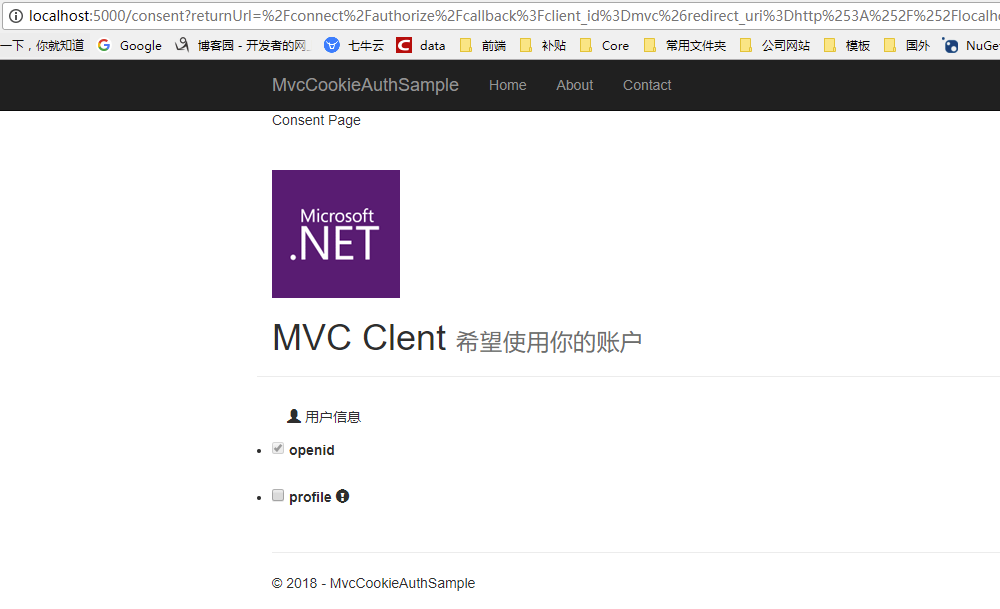
Consent 确认逻辑实现
首先我们在 ViewModels 文件夹中增加一个类 InputConsentViewModel.cs 用于接收 Consent/Index.cshtml 提交的表单信息

public class InputConsentViewModel { /// <summary> /// 按钮 /// </summary> public string Button { get; set; } /// <summary> /// 接收到的勾选的Scope /// </summary> public IEnumerable<string> ScopesConsented { get; set; } /// <summary> /// 是否选择记住 /// </summary> public bool RememberConsent { get; set; } /// <summary> /// 跳转地址 /// </summary> public string ReturnUrl { get; set; } }
然后修改 ConsentViewModel.cs ,加入ReturnUrl
public class ConsentViewModel { public string ClientId { get; set; } public string ClientName { get; set; } public string ClientUrl { get; set; } public string ClientLogoUrl { get; set; } public bool AllowRememberConsent { get; set; } public IEnumerable<ScopeViewModel> IdentityScopes { get; set; } public IEnumerable<ScopeViewModel> ResourceScopes { get; set; } public string ReturnUrl { get; set; } }
然后修改 Consent\Index.cshtml ,加入ReturnUrl

然后修改 Controllers\ConsentController.cs 中的 BuildConsentViewModel 方法
private async Task<ConsentViewModel> BuildConsentViewModel(string returnUrl) { AuthorizationRequest request = await _identityServerInteractionService.GetAuthorizationContextAsync(returnUrl); if (request == null) { return null; } Client client = await _clientStore.FindEnabledClientByIdAsync(request.ClientId); Resources resources = await _resourceStore.FindEnabledResourcesByScopeAsync(request.ScopesRequested); var vm= CreateConsentViewModel(request, client, resources); vm.ReturnUrl = returnUrl; return vm; }
然后在 Controllers\ConsentController.cs 中添加action

[HttpPost] public async Task<IActionResult> Index(InputConsentViewModel viewModel) { ConsentResponse consentResponse=null; if (viewModel.Button == "no") { consentResponse= ConsentResponse.Denied; } else if (viewModel.Button == "yes") { if (viewModel.ScopesConsented!=null&&viewModel.ScopesConsented.Any()) { consentResponse = new ConsentResponse() { RememberConsent = viewModel.RememberConsent, ScopesConsented = viewModel.ScopesConsented }; } } if ( consentResponse!=null) { var request =await _identityServerInteractionService.GetAuthorizationContextAsync(viewModel.ReturnUrl); await _identityServerInteractionService.GrantConsentAsync(request, consentResponse); return Redirect(viewModel.ReturnUrl); } var model = await BuildConsentViewModel(viewModel.ReturnUrl); if (model == null) { } return View(model); }
然后将 ViewModels\ConsentViewModel.cs 中 ConsentViewModel 的 AllowRememberConsent 改为 RememberConsent ,这样才能与 ViewModels\InputConsentViewModel.cs 保持一致
public class ConsentViewModel:InputConsentViewModel { public string ClientId { get; set; } public string ClientName { get; set; } public string ClientUrl { get; set; } public string ClientLogoUrl { get; set; } //public bool RememberConsent { get; set; } public IEnumerable<ScopeViewModel> IdentityScopes { get; set; } public IEnumerable<ScopeViewModel> ResourceScopes { get; set; } //public string ReturnUrl { get; set; } }
最后修改视图 Consent\Index.cshtml ,加入记住选项和确认按钮

@using MvcCookieAuthSample.ViewModels; @model ConsentViewModel <p>Consent Page</p> <!--Client Info--> <div class="row page-header"> <div class="col-sm-10"> @if (!string.IsNullOrWhiteSpace(Model.ClientLogoUrl)) { <div><img src="@Model.ClientLogoUrl" /></div> } <h1> @Model.ClientId <small>希望使用您的账户</small> </h1> </div> </div> <!--Scope Info--> <div class="row"> <div class="col-sm-8"> <form asp-action="Index" method="post"> <input type="hidden" asp-for="ReturnUrl"/> @if (Model.IdentityScopes.Any()) { <div> <div class="panel-heading"> <span class="glyphicon glyphicon-user"></span> 用户信息 </div> <ul class="list-group"> @foreach (var scope in Model.IdentityScopes) { @Html.Partial("_ScopeListitem", scope) } </ul> </div> } @if (Model.ResourceScopes.Any()) { <div> <div class="panel-heading"> <span class="glyphicon glyphicon-tasks"></span> 应用权限 </div> <ul class="list-group"> @foreach (var scope in Model.ResourceScopes) { @Html.Partial("_ScopeListitem", scope) } </ul> </div> } <div> <label> <input type="checkbox" asp-for="RememberConsent"/> <strong>记住我的选择</strong> </label> </div> <div> <button name="button" value="yes" class="btn btn-primary" autofocus>同意</button> <button name="button" value="no" >取消</button> @if (!string.IsNullOrEmpty(Model.ClientUrl)) { <a href="@Model.ClientUrl" class="pull-right btn btn-default"> <span class="glyphicon glyphicon-info-sign"></span> <strong>@Model.ClientUrl</strong> </a> } </div> </form> </div> </div>
修改视图 Views\Consent\_ScopeListitem.cshtml

@using MvcCookieAuthSample.ViewModels; @model ScopeViewModel <li> <label> <input type="checkbox" name="ScopesConsented" id="scopes_@Model.Name" value="@Model.Name" checked="@Model.Checked" disabled="@Model.Required"/> @if (Model.Required) { <input type="hidden" name="ScopesConsented" value="@Model.Name"/> } <strong>@Model.Name</strong> @if (Model.Emphasize) { <span class="glyphicon glyphicon-exclamation-sign"></span> } </label> @if (!string.IsNullOrWhiteSpace(Model.Description)) { <div> <label for="scopes_@Model.Name">@Model.Description</label> </div> } </li>
运行效果
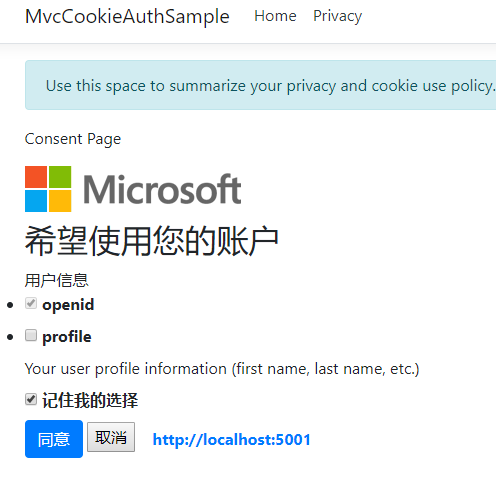
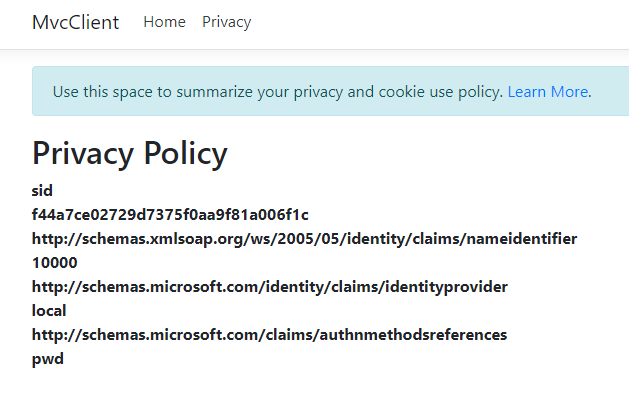
Asp.Net Core2.2源码:链接: https://pan.baidu.com/s/1pndxJwqpTsHmNmfQsQ0_2w 提取码: jxwd
Consent 代码重构
新建 Services 文件夹,添加 ConsentService.cs 用于业务封装

public class ConsentService { private readonly IClientStore _clientStore; private readonly IResourceStore _resourceStore; private readonly IIdentityServerInteractionService _identityServerInteractionService; public ConsentService(IClientStore clientStore , IResourceStore resourceStore , IIdentityServerInteractionService identityServerInteractionService) { _clientStore = clientStore; _resourceStore = resourceStore; _identityServerInteractionService = identityServerInteractionService; } public async Task<ConsentViewModel> BuildConsentViewModel(string returnUrl,InputConsentViewModel model=null) { AuthorizationRequest request = await _identityServerInteractionService.GetAuthorizationContextAsync(returnUrl); if (request == null) { return null; } Client client = await _clientStore.FindEnabledClientByIdAsync(request.ClientId); Resources resources = await _resourceStore.FindEnabledResourcesByScopeAsync(request.ScopesRequested); var vm = CreateConsentViewModel(request, client, resources,model); vm.ReturnUrl = returnUrl; return vm; } public async Task<ProcessConsentResult> ProcessConsent(InputConsentViewModel model) { ConsentResponse consentResponse = null; var result=new ProcessConsentResult(); if (model.Button == "no") { consentResponse = ConsentResponse.Denied; } else if (model.Button == "yes") { if (model.ScopesConsented != null && model.ScopesConsented.Any()) { consentResponse = new ConsentResponse() { RememberConsent = model.RememberConsent, ScopesConsented = model.ScopesConsented }; } else { result.ValidationError = "请至少选择一个权限"; } } if (consentResponse != null) { var request = await _identityServerInteractionService.GetAuthorizationContextAsync(model.ReturnUrl); await _identityServerInteractionService.GrantConsentAsync(request, consentResponse); result.RedirectUrl = model.ReturnUrl; } else { ConsentViewModel consentViewModel = await BuildConsentViewModel(model.ReturnUrl,model); result.ViewModel = consentViewModel; } return result; } #region Private Methods private ConsentViewModel CreateConsentViewModel(AuthorizationRequest request, Client client, Resources resources,InputConsentViewModel model) { var rememberConsent = model?.RememberConsent ?? true; var selectedScopes = model?.ScopesConsented ?? Enumerable.Empty<string>(); var vm = new ConsentViewModel(); vm.ClientName = client.ClientName; vm.ClientLogoUrl = client.LogoUri; vm.ClientUrl = client.ClientUri; vm.RememberConsent = rememberConsent; vm.IdentityScopes = resources.IdentityResources.Select(i => CreateScopeViewModel(i,selectedScopes.Contains(i.Name)||model==null)); vm.ResourceScopes = resources.ApiResources.SelectMany(i => i.Scopes).Select(i => CreateScopeViewModel(i, selectedScopes.Contains(i.Name)||model==null)); return vm; } private ScopeViewModel CreateScopeViewModel(IdentityResource identityResource,bool check) { return new ScopeViewModel() { Name = identityResource.Name, DisplayName = identityResource.DisplayName, Description = identityResource.Description, Required = identityResource.Required, Checked = check|| identityResource.Required, Emphasize = identityResource.Emphasize }; } private ScopeViewModel CreateScopeViewModel(Scope scope, bool check) { return new ScopeViewModel() { Name = scope.Name, DisplayName = scope.DisplayName, Description = scope.Description, Required = scope.Required, Checked = check||scope.Required, Emphasize = scope.Emphasize }; } #endregion }
Asp.Net Core2.2源码(重构):链接: https://pan.baidu.com/s/1mVdPDfDiDVToLSV9quC5KQ 提取码: 3dsq
集成ASP.NETCore Identity
EF实现
首先我们添加一个Data文件夹
我们首先在Models文件夹下面新建ApplicationUser.cs与ApplicationUserRole.cs
ApplicationUser.cs代码:
using Microsoft.AspNetCore.Identity; namespace MvcCookieAuthSample.Models { public class ApplicationUser:IdentityUser<int>//不加int的话是默认主键为guid { } }
ApplicationUserRole.cs代码:
using Microsoft.AspNetCore.Identity; namespace MvcCookieAuthSample.Models { public class ApplicationUserRole: IdentityRole<int>//不加int的话是默认主键为guid { } }
然后在Data文件夹下新建一个ApplicationDbContext.cs类,使它继承IdentityDbContext
using Microsoft.AspNetCore.Identity.EntityFrameworkCore; using Microsoft.EntityFrameworkCore; using MvcCookieAuthSample.Models; namespace MvcCookieAuthSample.Data { public class ApplicationDbContext:IdentityDbContext<ApplicationUser, ApplicationUserRole,int> { public ApplicationDbContext(DbContextOptions<ApplicationDbContext> options):base(options) { } } }
然后我们需要在Startup.cs添加EF的注册进来
//使用配置ApplicationDbContext使用sqlserver数据库,并配置数据库连接字符串 services.AddDbContext<ApplicationDbContext>(options=> { options.UseSqlServer(Configuration.GetConnectionString("DefaultConnection")); });
然后我们需要在appsettings.json中配置数据库连接字符串
"ConnectionStrings": { "DefaultConnection": "Server=127.0.0.1;Database=aspnet-IdentitySample;Trusted_Connection=True;MultipleActiveResultSets=true;uid=sa;pwd=123456" }
EF实现结束
Identity实现
我们需要在Startup.cs添加Identity的注册进来
//配置Identity services.AddIdentity<ApplicationUser, ApplicationUserRole>() .AddEntityFrameworkStores<ApplicationDbContext>() .AddDefaultTokenProviders();
由于默认的Identity在密码上限制比较严格,我们把它改的宽松简单一点(不设置也行)
//修改Identity密码强度设置配置 services.Configure<IdentityOptions>(options => { options.Password.RequireLowercase = false; //需要小写 options.Password.RequireNonAlphanumeric = false; //需要字母 options.Password.RequireUppercase = false; //需要大写 });
然后我们要修改 IdentityServer 的配置,首先要添加Nuget包
IdentityServer4.AspNetIdentity
services.AddIdentityServer() .AddDeveloperSigningCredential()//添加开发人员签名凭据 .AddInMemoryApiResources(Config.GetApiResources())//添加内存apiresource .AddInMemoryClients(Config.GetClients())//添加内存client .AddInMemoryIdentityResources(Config.GetIdentityResources())//添加系统中的资源 //.AddTestUsers(Config.GetTestUsers())//添加测试用户(这里不需要测试用户了) .AddAspNetIdentity<ApplicationUser>();
然后我们修改AccountController,修改代码,替换掉TestUsers的功能
private readonly UserManager<ApplicationUser> _userManager;//创建用户的 private readonly SignInManager<ApplicationUser> _signInManager;//用来登录的 private readonly IIdentityServerInteractionService _interaction; //依赖注入 public AccountController(UserManager<ApplicationUser> userManager , SignInManager<ApplicationUser> signInManager , IIdentityServerInteractionService interaction) { _userManager = userManager; _signInManager = signInManager; _interaction = interaction; }
完整的AccountController

using System; using System.Collections.Generic; using System.Linq; using System.Threading.Tasks; using IdentityServer4.Services; using IdentityServer4.Test; using Microsoft.AspNetCore.Authentication; using Microsoft.AspNetCore.Identity; using Microsoft.AspNetCore.Mvc; using MvcCookieAuthSample.Models; using MvcCookieAuthSample.ViewModels; namespace MvcCookieAuthSample.Controllers { public class AccountController : Controller { //private TestUserStore _users; //public AccountController(TestUserStore users) //{ // _users = users; //} private readonly UserManager<ApplicationUser> _userManager;//创建用户的 private readonly SignInManager<ApplicationUser> _signInManager;//用来登录的 private readonly IIdentityServerInteractionService _interaction; //依赖注入 public AccountController(UserManager<ApplicationUser> userManager , SignInManager<ApplicationUser> signInManager , IIdentityServerInteractionService interaction) { _userManager = userManager; _signInManager = signInManager; _interaction = interaction; } public IActionResult Register(string returnUrl = null) { ViewData["returnUrl"] = returnUrl; return View(); } [HttpPost] public async Task<IActionResult> Register(RegisterViewModel registerViewModel, string returnUrl = null) { var identityUser = new ApplicationUser { Email = registerViewModel.Email, UserName = registerViewModel.Email, NormalizedUserName = registerViewModel.Email }; var identityResult = await _userManager.CreateAsync(identityUser, registerViewModel.Password); if (identityResult.Succeeded) { return RedirectToAction("Index", "Home"); } return View(); } public IActionResult Login(string returnUrl = null) { ViewData["returnUrl"] = returnUrl; return View(); } [HttpPost] public async Task<IActionResult> Login(LoginViewModel loginViewModel, string returnUrl = null) { if (ModelState.IsValid) { ViewData["returnUrl"] = returnUrl; var user =await _userManager.FindByEmailAsync(loginViewModel.Email); if (user==null) { ModelState.AddModelError(nameof(loginViewModel.Email),"UserName not exist"); } else { if (await _userManager.CheckPasswordAsync(user,loginViewModel.Password)) { AuthenticationProperties prop = null; if (loginViewModel.RememberMe) { prop = new AuthenticationProperties() { IsPersistent = true, ExpiresUtc = DateTimeOffset.UtcNow.Add(TimeSpan.FromMinutes(30)) }; } //await Microsoft.AspNetCore.Http.AuthenticationManagerExtensions.SignInAsync(HttpContext, // user.SubjectId, user.Username,prop); //return RedirectToLocal(returnUrl); await _signInManager.SignInAsync(user, prop); if (_interaction.IsValidReturnUrl(returnUrl)) { return Redirect(returnUrl); } return Redirect("~/"); } ModelState.AddModelError(nameof(loginViewModel.Password),"Wrong Password"); } } return View(loginViewModel); } public async Task<IActionResult> LogOut() { await _signInManager.SignOutAsync(); //await HttpContext.SignOutAsync(); return RedirectToAction("Index", "Home"); } //内部跳转 private IActionResult RedirectToLocal(string returnUrl) { if (Url.IsLocalUrl(returnUrl)) { return Redirect(returnUrl); } return RedirectToAction("Index", "Home"); } //添加验证错误 private void AddError(IdentityResult result) { //遍历所有的验证错误 foreach (var error in result.Errors) { //返回error到model ModelState.AddModelError(string.Empty, error.Description); } } } }
接下来我们重新生成一下,我们需要执行shell命令生成一下数据库
dotnet ef migrations add VSInit

这时候Migrations文件夹下已经有新增的数据库更新配置文件了
DbContextSeed初始化
由于我们现在每次EF实体模型变化的时候每次都是手动更改,我们想通过代码的方式让他自动更新,或者程序启动的时候添加一些数据进去
首先,在Data文件夹下添加一个ApplicationDbContextSeed.cs初始化类

public class ApplicationDbContextSeed { private UserManager<ApplicationUser> _userManager; public async Task SeedAsync(ApplicationDbContext context, IServiceProvider services) { if (!context.Users.Any()) { _userManager = services.GetRequiredService<UserManager<ApplicationUser>>(); var defaultUser = new ApplicationUser { UserName = "Administrator", Email = "786744873@qq.com", NormalizedUserName = "admin" }; var result = await _userManager.CreateAsync(defaultUser, "Password$123"); if (!result.Succeeded) { throw new Exception("初始默认用户失败"); } } } }
那么如何调用呢?接下来我们写一个WebHost的扩展方法类WebHostMigrationExtensions.cs来调用ApplicationDbContextSeed方法

public static class WebHostMigrationExtensions { public static IWebHost MigrateDbContext<TContext>(this IWebHost host, Action<TContext, IServiceProvider> sedder) where TContext : DbContext { using (var scope = host.Services.CreateScope()) {//只在本区间内有效 var services = scope.ServiceProvider; var logger = services.GetRequiredService<ILogger<TContext>>(); var context = services.GetService<TContext>(); try { context.Database.Migrate(); sedder(context, services); logger.LogInformation($"执行DBContext {typeof(TContext).Name} seed执行成功"); } catch (Exception ex) { logger.LogError(ex, $"执行DBContext {typeof(TContext).Name} seed方法失败"); } } return host; } }
那么我们程序启动的时候要怎调用呢?
要在Program.cs中执行
public static void Main(string[] args) { CreateWebHostBuilder(args).Build() //自动初始化数据库开始 .MigrateDbContext<ApplicationDbContext>((context, services) => { new ApplicationDbContextSeed().SeedAsync(context, services).Wait(); }) //自动初始化数据库结束 .Run(); }
然后运行即可自动化创建数据库和数据
ProfileService实现(调试)
在 Services 文件夹下添加 ProfileService.cs

public class ProfileService : IProfileService { private readonly UserManager<ApplicationUser> _userManager;//创建用户的 public ProfileService(UserManager<ApplicationUser> userManager) { _userManager = userManager; } private async Task<List<Claim>> GetClaimsFromUserAsync(ApplicationUser user) { var claims=new List<Claim>() { new Claim(JwtClaimTypes.Subject,user.Id.ToString()), new Claim(JwtClaimTypes.PreferredUserName,user.UserName) }; var roles =await _userManager.GetRolesAsync(user); foreach (var role in roles) { claims.Add(new Claim(JwtClaimTypes.Role,role)); } if (!string.IsNullOrWhiteSpace(user.Avatar)) { claims.Add(new Claim("avatar", user.Avatar)); } return claims; } public async Task GetProfileDataAsync(ProfileDataRequestContext context) { var subjectId = context.Subject.Claims.FirstOrDefault(c => c.Type == "sub").Value; var user = await _userManager.FindByIdAsync(subjectId); var claims =await GetClaimsFromUserAsync(user); context.IssuedClaims = claims; } public async Task IsActiveAsync(IsActiveContext context) { context.IsActive = false; var subjectId = context.Subject.Claims.FirstOrDefault(c => c.Type == "sub").Value; var user = await _userManager.FindByIdAsync(subjectId); context.IsActive = user != null; } }
修改 Config.cs 中的GetClients方法
public static IEnumerable<Client> GetClients() { return new Client[] { new Client() { ClientId = "mvc", AllowedGrantTypes = GrantTypes.HybridAndClientCredentials,//模式:混合模式 ClientSecrets =//私钥 { new Secret("secret".Sha256()) }, AllowedScopes =//运行访问的资源 { IdentityServerConstants.StandardScopes.OpenId, IdentityServerConstants.StandardScopes.Profile, IdentityServerConstants.StandardScopes.Email, IdentityServerConstants.StandardScopes.OfflineAccess, "api1" }, RedirectUris = { "http://localhost:5001/signin-oidc" },//跳转登录到的客户端的地址 PostLogoutRedirectUris = { "http://localhost:5001/signout-callback-oidc" },//跳转登出到的客户端的地址 RequireConsent=true,//是否需要用户点击确认进行跳转,改为点击确认后进行跳转 AlwaysIncludeUserClaimsInIdToken = true, AllowOfflineAccess = true,//允许脱机访问 ClientName = "MVC Client", ClientUri = "http://localhost:5001", LogoUri = "https://img-prod-cms-rt-microsoft-com.akamaized.net/cms/api/am/imageFileData/RE1Mu3b?ver=5c31", AllowRememberConsent = true, } }; }
修改 Startup.cs
services.AddIdentityServer() .AddDeveloperSigningCredential()//添加开发人员签名凭据 .AddInMemoryApiResources(Config.GetApiResources())//添加内存apiresource .AddInMemoryClients(Config.GetClients())//添加内存client .AddInMemoryIdentityResources(Config.GetIdentityResources())//添加系统中的资源 //.AddTestUsers(Config.GetTestUsers())//添加测试用户(这里不需要测试用户了) .AddAspNetIdentity<ApplicationUser>() .Services.AddScoped<IProfileService,ProfileService>();
修改MvcClient项目中的 Startup.cs
services.AddAuthentication(options => { options.DefaultScheme = "Cookies";//使用Cookies认证 options.DefaultChallengeScheme = "oidc";//使用oidc }) .AddCookie("Cookies")//配置Cookies认证 .AddOpenIdConnect("oidc", options =>//配置oidc { options.SignInScheme = "Cookies"; options.Authority = "http://localhost:5000"; options.RequireHttpsMetadata = false; options.ResponseType = OpenIdConnectResponseType.CodeIdToken; options.ClientId = "mvc"; options.ClientSecret = "secret"; options.SaveTokens = true; //options.GetClaimsFromUserInfoEndpoint = true; //options.ClaimActions.MapJsonKey("sub", "sub"); //options.ClaimActions.MapJsonKey("preferred_username", "preferred_username"); //options.ClaimActions.MapJsonKey("sub", "sub"); //options.ClaimActions.MapJsonKey("avatar", "avatar"); //options.ClaimActions.MapCustomJson("role", jobj => jobj["role"].ToString()); options.Scope.Add("offline_access"); options.Scope.Add("openid"); options.Scope.Add("profile"); });
源码:链接: https://pan.baidu.com/s/1EM-MC9N6RKb6MS2KjccIig 提取码: cq4c
集成EFCore配置Client和API
接下来的步骤是,以取代当前 AddInMemoryClients,AddInMemoryIdentityResources和AddInMemoryApiResources 在ConfigureServices在方法Startup.cs。我们将使用以下代码替换它们:
修改MvcCookieAuthSample项目中的ConfigureServices方法,copy链接字符串,这是一个官方的字符串,直接复制过来,放在上面。
const string connectionString = @"Data Source=(LocalDb)\MSSQLLocalDB;database=IdentityServer4.Quickstart.EntityFramework-2.0.0;trusted_connection=yes;";

添加包的引用
IdentityServer4.EntityFramework
引入IdentityServer4.EntityFramework的命名空间
初始化我们的数据库,OperationStore的配置。这里实际上有两套表, 一套存Client这些信息,Operation这套用来存token
加上ConfigrationStore和OperationStore以后就可以移除上面的三行代码,那三行代码之前都是从Config类里面获取数据的,先在通过数据库的方式去回去,所以这里不再需要了
services.AddIdentityServer() .AddDeveloperSigningCredential()//添加开发人员签名凭据 //.AddInMemoryApiResources(Config.GetApiResources())//添加内存apiresource //.AddInMemoryClients(Config.GetClients())//添加内存client //.AddInMemoryIdentityResources(Config.GetIdentityResources())//添加系统中的资源 .AddConfigurationStore(options => { options.ConfigureDbContext = builder => { builder.UseSqlServer(connectionString,sql=>sql.MigrationsAssembly(migrationsAssembly)); }; }) // this adds the operational data from DB (codes, tokens, consents) .AddOperationalStore(options => { options.ConfigureDbContext = b => b.UseSqlServer(connectionString, sql => sql.MigrationsAssembly(migrationsAssembly)); // this enables automatic token cleanup. this is optional. options.EnableTokenCleanup = true; }) //.AddTestUsers(Config.GetTestUsers())//添加测试用户(这里不需要测试用户了) .AddAspNetIdentity<ApplicationUser>() .Services.AddScoped<IProfileService,ProfileService>();
添加数据库迁移
Add-Migration init -Context PersistedGrantDbContext -OutputDir Data/Migrations/IdentityServer/PersistedGrantDb
Add-Migration init -Context ConfigurationDbContext -OutputDir Data/Migrations/IdentityServer/ConfigurationDb
更新数据库结构
Update-Database -c ConfigurationDbContext
这时数据库会生成库和表结构
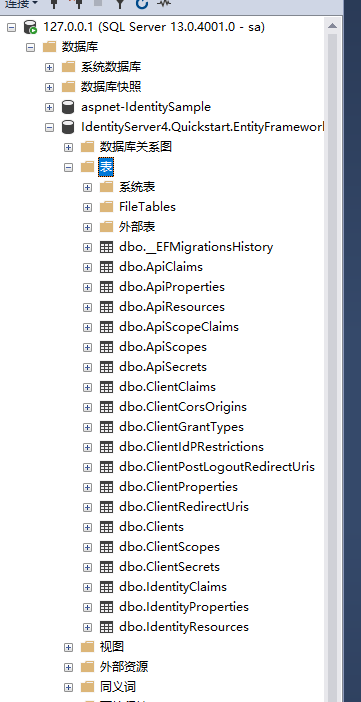
初始化数据
在Startup.cs中添加此方法以帮助初始化数据库:

private void InitializeDatabase(IApplicationBuilder app) { using (var serviceScope = app.ApplicationServices.GetService<IServiceScopeFactory>().CreateScope()) { serviceScope.ServiceProvider.GetRequiredService<PersistedGrantDbContext>().Database.Migrate(); var context = serviceScope.ServiceProvider.GetRequiredService<ConfigurationDbContext>(); context.Database.Migrate(); if (!context.Clients.Any()) { foreach (var client in Config.GetClients()) { context.Clients.Add(client.ToEntity()); } context.SaveChanges(); } if (!context.IdentityResources.Any()) { foreach (var resource in Config.GetIdentityResources()) { context.IdentityResources.Add(resource.ToEntity()); } context.SaveChanges(); } if (!context.ApiResources.Any()) { foreach (var resource in Config.GetApiResources()) { context.ApiResources.Add(resource.ToEntity()); } context.SaveChanges(); } } }
然后我们可以从 Configure 方法中调用它:
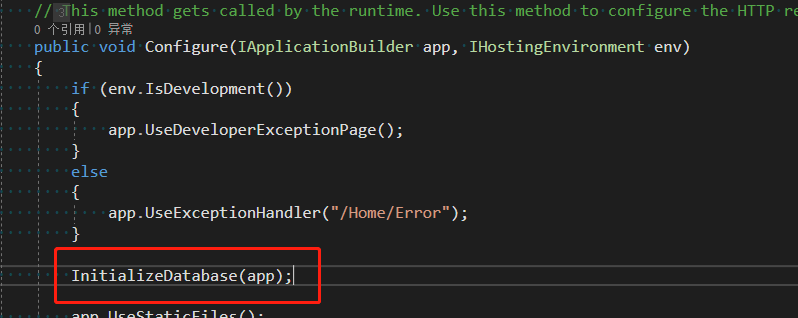
然后运行,我们可以看到在 Clients 表中已经有了数据

源码:链接: https://pan.baidu.com/s/1BauxqrclWtlOJk9h6uxtAg 提取码: dq4e
-------------------------------------------
个性签名:独学而无友,则孤陋而寡闻。做一个灵魂有趣的人!
如果觉得这篇文章对你有小小的帮助的话,记得在右下角点个“推荐”哦,博主在此感谢!
万水千山总是情,打赏一分行不行,所以如果你心情还比较高兴,也是可以扫码打赏博主,哈哈哈(っ•̀ω•́)っ✎⁾⁾!





 浙公网安备 33010602011771号
浙公网安备 33010602011771号